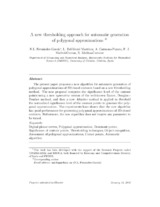Mostrar el registro sencillo del ítem
A new thresholding approach for automatic generation of polygonal approximations
| dc.contributor.author | Fernández García, Nicolás Luis | |
| dc.contributor.author | Moral Martínez, Luis del | |
| dc.contributor.author | Carmona Poyato, Ángel | |
| dc.contributor.author | Medina-Carnicer, R. | |
| dc.contributor.author | Madrid-Cuevas, F.J. | |
| dc.date.accessioned | 2017-12-20T12:40:07Z | |
| dc.date.available | 2017-12-20T12:40:07Z | |
| dc.date.issued | 2016 | |
| dc.identifier.uri | http://hdl.handle.net/10396/15764 | |
| dc.description.abstract | The present paper proposes a new algorithm for automatic generation of polygonal approximations of 2D closed contours based on a new thresholding method. The new proposal computes the signi cance level of the contour points using a new symmetric version of the well-known Ramer, Douglas - Peucker method, and then a new Adaptive method is applied to threshold the normalized signi cance level of the contour points to generate the polygonal approximation. The experiments have shown that the new algorithm has good performance for generating polygonal approximations of 2D closed contours. Futhermore, the new algorithm does not require any parameter to be tuned. | es_ES |
| dc.format.mimetype | application/pdf | es_ES |
| dc.language.iso | eng | es_ES |
| dc.publisher | Elsevier | |
| dc.rights | https://creativecommons.org/licenses/by-nc-nd/4.0/ | es_ES |
| dc.source | Journal of Visual Communication and Image Representation 35, 155-168 (2016) | |
| dc.subject | Digital planar curves | es_ES |
| dc.subject | Polygonal approximation | es_ES |
| dc.subject | Dominant points | es_ES |
| dc.subject | Significance of contour points | es_ES |
| dc.subject | Thresholding techniques | es_ES |
| dc.subject | Object recognition | es_ES |
| dc.subject | Assessment of polygonal approximations | es_ES |
| dc.subject | Corner points | es_ES |
| dc.subject | Automatic algorithm | es_ES |
| dc.title | A new thresholding approach for automatic generation of polygonal approximations | es_ES |
| dc.type | info:eu-repo/semantics/preprint | es_ES |
| dc.relation.publisherversion | http://dx.doi.org/10.1016/j.jvcir.2015.12.013 | es_ES |
| dc.relation.projectID | Gobierno de España. TIN2012-32952 | es_ES |
| dc.rights.accessRights | info:eu-repo/semantics/openAccess | es_ES |

